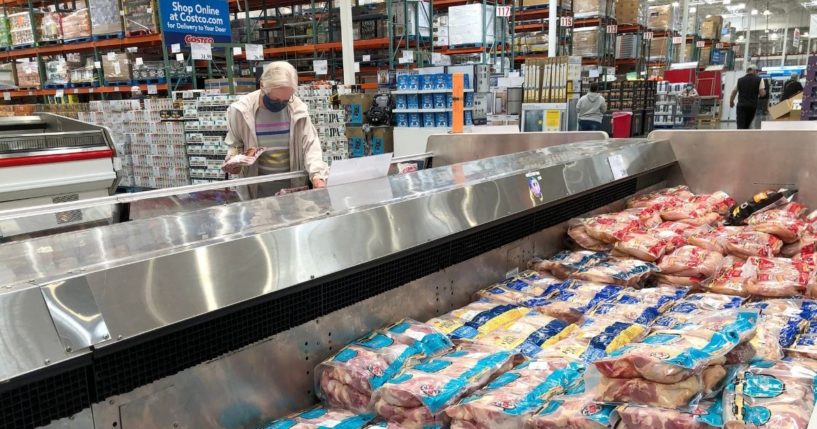
Inflation Spikes Again, Surges at Fastest Rate in Nearly 40 Years
Inflation jumped at its fastest pace in nearly 40 years last month, a 7 percent spike from a year earlier that is pushing up household expenses, eating into wage gains and heaping pressure on President Joe Biden and the Federal Reserve to address a growing threat to the U.S. economy.
That increase represented the biggest jump since June 1982, when inflation hit 7.1 percent.
Prices have risen sharply for gas, food, cars and furniture amid shortages of workers and raw materials that have squeezed supply chains.
The Labor Department reported Wednesday that excluding volatile food and gas prices, so-called core prices surged 0.6 percent from November to December. Measured year over year, core prices jumped 5.5 percent in December, the fastest such increase since 1991.
Rising prices have made it harder for households, especially lower-income families, to afford basic expenses.
Polls show that inflation has started displacing even the coronavirus as a public concern, making clear the political threat it poses to Biden and congressional Democrats.
A significant portion of inflation is still being driven by pandemic-driven mismatches between demand and supply. Used car prices have soared more than 37 percent over the past year because new car production has been restrained by shortages of semiconductors.
Shortages and higher prices at U.S. grocery stores have also grown in recent weeks as new problems, like the omicron variant and severe weather, have compounded supply chain problems.
Republicans point to trillions of dollars in federal spending under Biden and a Democratic Congress as the driving force behind skyrocketing prices.
“Inflation surges 7% in December, highest rate in 40 years”
This is the inevitable result of Dems’ reckless spending policies that have flooded the economy with more than $2 trillion in stimulus and demand-side spending.https://t.co/O18iBYqHgW
— Rob Portman (@senrobportman) January 12, 2022
Inflation has surged to the highest levels in 40 YEARS – reaching 7% over the past year.
There is no denying President Biden and Democrats’ out of control spending has fueled the #BidenInflation Crisis and Americans are paying the price at every corner.https://t.co/FyEAdxNji7
— Rep. Roger Williams (@RepRWilliams) January 12, 2022
Many restaurants have been passing along higher labor and food costs to their customers. Darden Restaurants, the company that owns Olive Garden, LongHorn Steakhouse and other chains, said it increased prices by 2 percent at the end of last year and expects to bump them by another 4 percent over the next six months.
Darden CEO Gene Lee recently told investors recently that this is “the toughest inflationary environment we’ve seen in years.”
On Tuesday, Fed Chairman Jerome Powell told Congress that if it becomes necessary to fight high inflation more aggressively, the Federal Reserve is prepared to accelerate the interest rate hikes it plans to begin this year.
Fed officials have estimated that they will raise their benchmark short-term rate, now pegged near zero, three times this year. Many economists envision as many as four Fed rate hikes in 2022.
Those rate increases would likely increase borrowing costs for home and auto purchases as well as for business loans, potentially slowing the economy.
The rate hikes also mark a sharp reversal in policy by Fed policymakers, who as recently as September had been split over whether to raise rates even once this year.
The Fed is also rapidly ending its monthly bond purchases, which were intended to lower longer-term interest rates to encourage borrowing and spending.
Yet the Fed’s quick pivot hasn’t quelled questions from many former Fed officials, economists and some senators about whether the Fed has acted too slowly to end its ultra-low-interest rate policies in the face of accelerating inflation — and put the economy at risk as a result.
In his testimony to Congress on Tuesday, Powell said the Fed mistakenly believed that supply chain bottlenecks that have helped drive up the prices of goods wouldn’t last nearly as long as they have. Once the supply chains were unsnarled, he said, prices would come back down.
Yet for now, the supply problems have persisted, and though there are signs that they are loosening in some industries, Powell acknowledged that progress has been limited.
He noted that many cargo ships remain docked outside the port of Los Angeles and Long Beach, the nation’s largest, waiting to unload.
With the Biden administration facing public discontent over the rise in inflation, the president has claimed his administration’s investments in ports, roads, bridges and other infrastructure would help by loosening snarled supply chains.
The Western Journal has reviewed this Associated Press story and may have altered it prior to publication to ensure that it meets our editorial standards.
Truth and Accuracy
We are committed to truth and accuracy in all of our journalism. Read our editorial standards.
Advertise with The Western Journal and reach millions of highly engaged readers, while supporting our work. Advertise Today.












